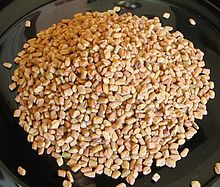 |
|
|
|
|
| Cuisines | Herbal | Spice | Curry | Yeast | Recipe | ||||||
|
Fenugreek Fenugreek ( /ˈfɛnjʉɡriːk/; Trigonella foenum-graecum) is an annual plant in the family Fabaceae. The plant has small round leaves is cultivated worldwide as a semi-arid crop and is a common ingredient in dishes from Pakistan and the Indian Subcontinent, where it is known as methi in Urdu, Hindi and Nepali, as menthiyam and venthayam (வெந்தயம்) in Tamil, and as menthya (ಮೆಂತ್ಯ) in Kannada uluwa in malayalam' 'menthulu in Telugu". Seeds Fenugreek seeds are a rich source of the polysaccharide galactomannan. They are also a source of saponins such as diosgenin, yamogenin, gitogenin, tigogenin, and neotigogens. Other bioactive constituents of fenugreek include mucilage, volatile oils, and alkaloids such as choline and trigonelline. Fenugreek seeds are used as a medicinal in Traditional Chinese Medicine under the name Hu Lu Ba (Traditional Chinese: 胡蘆巴, Simplified Chinese: 胡芦巴, Pinyin: hú lú bā), where they are considered to warm and tonify kidneys, disperse cold and alleviate pain. Main indications are hernia, pain in the groin. They are used raw or toasted. In India about 2-3g of raw fenugreek seeds are swallowed early in the morning with warm water, before brushing the teeth and before drinking tea or coffee, where they are supposed to have a therapeutic and healing effect on joint pains, without any side effects. In Persian cuisine Fenugreek leaves are used and called شنبلیله (shanbalile). In Arabic traditional medicine, it is known as حلبه (Helba or Hulba). Tea made from the seeds is used in the Near East to treat various kidney, heart, abdominal illnesses and Diabetes. Seeds are used by Bedouin women to strengthen pregnant and breastfeeding women. Fenugreek is frequently used in the production of flavoring for artificial maple syrups. The taste of toasted fenugreek, like cumin, is additionally based on substituted pyrazines. By itself, fenugreek has a bitter taste. Fenugreek seed is widely used as a galactagogue (milk producing agent) by nursing mothers to increase inadequate breast milk supply. Studies have shown that fenugreek is a potent stimulator of breast milk production and its use was associated with increases in milk production. It can be found in capsule form in many health food stores. Several human intervention trials demonstrated that the antidiabetic effects of fenugreek seeds ameliorate most metabolic symptoms associated with type-1 and type-2 diabetes in both humans and relevant animal models by reducing serum glucose and improving glucose tolerance. Fenugreek is currently available commercially in encapsulated forms and is being prescribed as dietary supplements for the control of hypercholesterolemia and diabetes by practitioners of complementary and alternative medicine. Cooking UseFenugreek has three culinary uses: as an herb (dried or fresh leaves), as a spice (seeds), and as a vegetable (fresh leaves, sprouts, and microgreens). The distinctive cuboid-shaped, yellow-to-amber coloured fenugreek seeds are frequently encountered in the cuisines of the Indian subcontinent. The seeds are used in the preparation of pickles, vegetable dishes, daals, and spice mixes, such as panch phoron and sambar powder. Fenugreek seeds are used both whole and in powdered form and are often roasted to reduce their bitterness and enhance their flavor. Fenugreek is also used as a vegetable. Fresh fenugreek leaves are an ingredient in some Indian curries. The sprouted seeds and microgreens are used in salads. When harvested as microgreens, fenugreek is known as Samudra Methi in Maharashtra, especially in and around Mumbai, where it is often grown near the sea in the sandy tracts, hence the name (Samudra, which means "ocean" in Sanskrit). Samudra Methi is also grown in dry river beds in the Gangetic plains. When sold as a vegetable in India, the young plants are harvested with their roots still attached. Any remaining soil is washed off and they are then sold in small bundles in the markets and bazaars to extend their shelf life. In Persian cuisine Fenugreek leaves are used and called شنبلیله (shanbalile). It is the key ingredient and one of several greens incorporated into ghormeh sabzi, often said to be the Iranian national dish. Fenugreek is used in Eritrean and Ethiopian cuisine. The word for fenugreek in Amharic is abesh (or abish), and the seed is used in Ethiopia as a natural herbal medicine in the treatment of diabetes. Yemenite Jews following the interpretation of Rabbi Salomon Isaacides, Rashi of Talmūd, believe fenugreek, which they call hilbeh, hilba, helba, or halba (חילבה) is the Talmudic Rubia (רוביא). They use fenugreek to produce a sauce also called hilbeh, reminiscent of curry. It is consumed daily but ceremoniously during the meal of the first and/or second night of Rosh Hashana (Jewish New Year). MedicinalA June 2011 study at the Australian Centre for Integrative Clinical and Molecular Medicine found that men aged 25 to 52 who took a fenugreek extract twice daily for six weeks scored 25% higher on tests gauging libido levels than those who took a placebo. LactationFenugreek seeds are thought to be a galactagogue that is often used to increase milk supply in lactating women. |











